#I have a dichotomous key
Text
we were talking today about goofball questions that customers ask. one of the office ladies has gotten: 'do you have the flowers that people plant in front of their houses?'
just, y'know, THE flowers. the only kind. that people plant. in front of their houses.
she eventually guessed: 'rhododendron?'
'THOSE!!!'
'no, we don't sell those.'
#byeee#there's a lot of 'can you help me find the thing I bought here last year?' 'do you have the tag or a photo or a description?' 'well...'#and they describe a flower color and shape. and then 20 minutes later shout at a table of smth COMPLETELY DIFFERENT going 'oh this is them!#like describing pink callies and leaving with. idk. yellow lantana. man. whatever.#I was a dichotomous key for you and this is how you treat me.
3 notes
·
View notes
Text
species categorization go

#FOR AN EXPLANATION OF THIS: ive made like a whole system of categorizing objects based on. yk what they are#somewhere I made a dichotomous key for computer assets; electrical; mechanical; and mechanical minds#damnit rip fuckers why do you have to be so weird to categorize /silly
4 notes
·
View notes
Text
When discussing or analyzing Dazai, one thing I hope you will keep in mind when reading anything I write about him is that from my perspective, he is always, always both.
What do I mean by this? Well, I find there tends to be a general split among people who hold the opinion that "he's a manipulator and will always be manipulative" and "he's doing his best to be good and helpful and live up to Oda's last wishes for him", of which, neither is completely right - because he is both. But even among the people who hold to this dual-nature interpretation, I find that his individual actions and motivations still tend to be thought of in a dichotomous manner - is it manipulative, or genuine?
Again, I think it's always both.
Dazai has a very pragmatic view on a lot of things - he is always looking for the usefulness of things and people so that the situation turns out in his favour. He's incredibly adept at this, and his prediction and placement and careful reveals are all manipulation tactics to get his allies and enemies doing exactly what he needs them to. I don't think anyone can contest this since we see it over and over in the series.
But that's not all there is to it. He's not solely manipulative and he does, to some extent, sympathize with others - I think there are several instances of this in the series, but I want to stress that this has been apparent since Chapter 1!
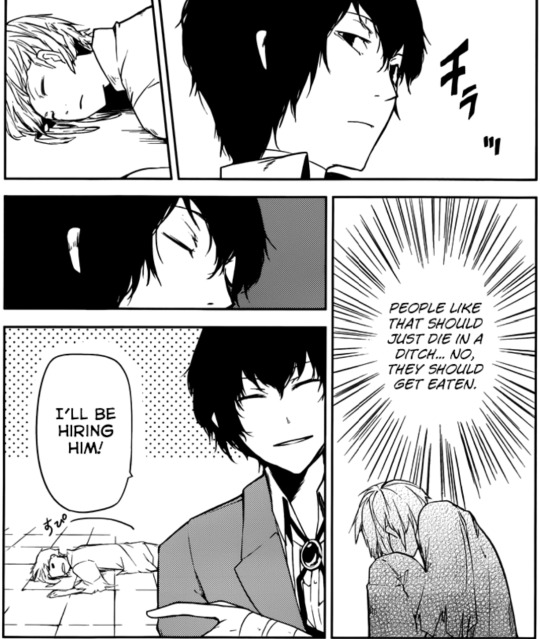
For context, Dazai is recalling what Atsushi said to him a few minutes earlier, but it's very interesting that it should be this specific part of the conversation. He could've flashed back to the part where Atsushi said he had nowhere to go; no money, no food - he is about to trick him into joining, after all, and this is the key piece he uses to basically force Atsushi into the Agency. But instead it's Atsushi's self-deprecation that catches his attention, and it really does, because even during the conversation, he turns to look at him after he says this with an odd expression.
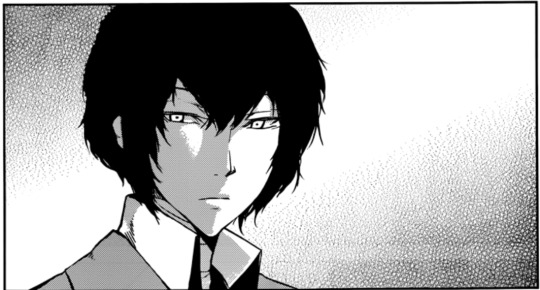
You could say that this makes Atsushi easier to manipulate, if that's your angle, but that can't be solely it, because in the later conversation with Hirotsu, we know Dazai was planning to bring Atsushi into the Agency and set him up as one half of the new Double Black the moment he met him. The panel shown there is the riverbank, set much earlier in the day than this scene. He was already planning to pair him with Akutagawa since he figured out he was the tiger, so what's with this reaction?
Well. Sometimes the simplest explanation is the best.
He manipulated Atsushi into joining with the intention of utilizing him in his future plans. He also helped him and gave him a place to belong, and importantly, he likes this kid! It's both.
I think much of it might be that his brain just kinda works way too fast - he's such a natural at crafting these elaborate plots and seeing how things connect and gathering useful people like resources that it's practically automatic - though this is not a great means when you're trying to be a kinder person. There's an omake, I believe, that has him saying "I like using my head for justice", i.e. using these underhanded means to act for the better. Not great, but those are the kind of gifts he has. He's way more suited to exploitation, but is choosing to use these tactics to save people now, which is quite reminiscent of what he tells Kyouka. Kyouka's talents lie in killing people - when what you're good at isn't who you want to be, what do you do? Well, I expect you use what you have, even if it's not ideal.
Now, about the current situation with Sigma - I think he definitely likes him, and is intrigued by him and his situation. We did get a little thought bubble where the guy amusedly compares him to Atsushi, and you can't tell me he doesn't care about Atsushi (listen to the onsen drama cd, or read 55 Minutes if you somehow don't believe me). But also, it's undeniable that Sigma is in a very vulnerable position of being homeless and having had no one be genuinely kind to him before. His trust is very easy to earn, and with the latest chapter, Dazai has now saved his life multiple times. There is, as always, a practical purpose he needs him for. And I have to be somewhat amused because Dazai is quite literally telling Sigma everything he ever wanted and needed to hear. It's a brilliant means of quickly endearing himself to Sigma - but I don't think that's all it is.
Look. The most honest moments we get in this series from Dazai are, interestingly for an expert manipulator, when people are at their most vulnerable. In spite of every pointlessly cruel act he inflicted on Akutagawa, his first meeting with him was open and transparent; much like the orphanage director, it seems he thought this treatment would make him strong and adaptable (he's wrong but that's not the point of this). He cuts Kyouka off in irritation and says "don't give me that" when she implies that she would fail the entrance exam. He tells Atsushi it's normal to cry after losing a father figure and to feel however you feel, even if that person caused you nothing but incredible pain and cannot be forgiven. He refuses to entertain Sigma's assumptions that Dazai sees himself as a superior being to him.

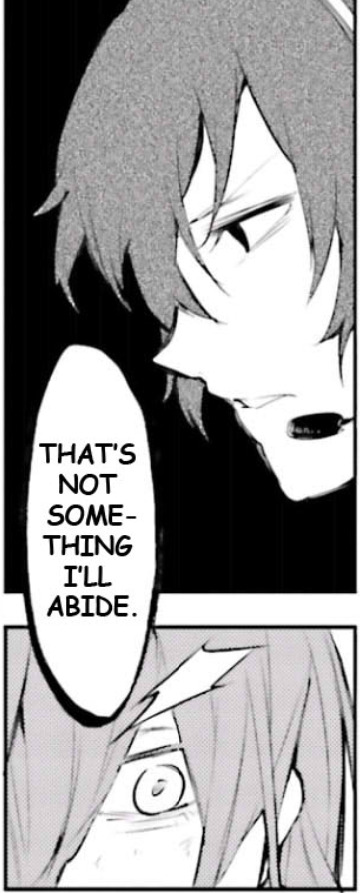
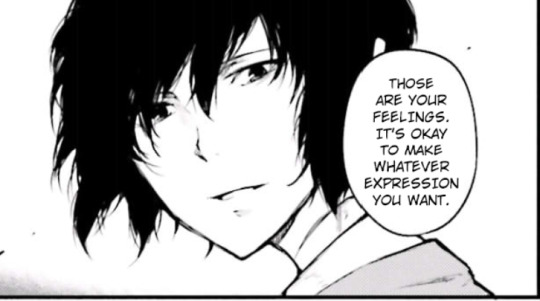
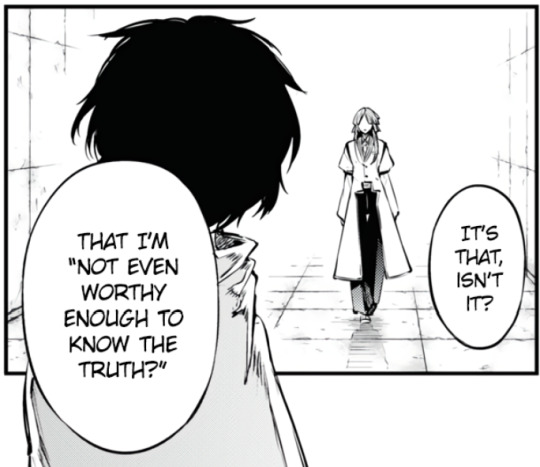

Selective honesty can also be utilized to great effect; Mori does this, and undoubtedly it serves this purpose for Dazai too. But I want to stress that I do sincerely believe this is all still honesty from him. Manipulation, or genuine?
Both. It's both.
#or to summarize: Dazai is a gemini (derogatory)#<- said as a fellow gemini (also derogatory)#the few exceptions to the always both rule are basically any of his interactions with odasaku#and the bit in sb where he tells chuuya about what activating corruption will entail#most everything else appears to have a dual reason.#to be clear: there's lots of ways to interpret dazai - but this is the approach i personally use in my analyses#so i'd love it if you guys would read my dazai analyses keeping this standpoint in mind :)#i think instead of debating 'is dazai bad' which is seriously kind of irrelevant to me#i'd love to talk a bit more about how dazai is actually quite helpful but also equally presumptuous about what will help people#we could also talk about the fine line between protectiveness and possessiveness with him too.#or about how drawn he is to kind people who value life likely because he's hoping to find answers or a vicarious experience#anything except the 'is he good or bad' debate. i don't like it. :/#bsd#bsd meta#bsd analysis#bsd dazai#storyrambles#oof i never know how things like this are going to go over.
737 notes
·
View notes
Text

Saturday, March 30, 2024
It felt weird doing school work on a Saturday, but I have done it before. I featured more of the yummy candy I received in the photo. I have eaten a little of it already, but I think it's going to last me several weeks, if not a couple of months. I do not eat candy much at all, which is strange because I love things that are sweet! Still, it's nice to have a treat at the end of the study day. I don't agree with giving food as a reward, but it feels that way, even though I would still eat it whether I finished all of my studying or not.
Tasks Completed:
Geometry - Reviewed simple probability, basic probability terms, and sample spaces and tree diagrams + reviewed the counting principle + practice
Lit and Comp II - Read chapter 47 of Emma by Jane Austen
Spanish 2 - Listened to Spanish speakers + answered questions in Spanish
Bible I - Read 1 Samuel 1
World History - Watched second half of The Rise and Fall of the Third Reich + added to my timeline
Biology with Lab - Completed dichotomous key assignment
PE/Health I - Read a health article about lead and the body
Foundations - Read the definition of sincerity + completed the next quiz on Read Theory + looked at more advertisements
Piano - Practiced for four hours in one hour split sessions
Khan Academy - Completed High School Biology Unit 7: Lesson 3 (parts 6-7)
CLEP - Completed Module 11 reading "Europe: 1918-1945" 13.10-13.10.2 + Watched Module 11.4 lecture video
Streaming - Watched Hitler’s Circle of Evil episodes 3 and 4
Duolingo - Studied for 15 minutes (Spanish, French, Chinese) + completed daily quests
Reading - Read pages 109-157 of Beneath the Wide Silk Sky by Emily Inouye Huey
Chores - Deep cleaned refrigerator, stove and kitchen counters + put away groceries
Activities of the Day:
Personal Bible Study (1 Corinthians 12 + Week 6 reflections)
1 hour gaming
2 hours yoga/stretch (split into one hour sessions)
Journal/Mindfulness
-
What I’m Grateful for Today:
I am grateful for smoothie bowls!
Quote of the Day:
Miracles happen everyday, change your perception of what a miracle is and you'll see them all around you.
-Jon Bon Jovi
🎧SUPERWOMAN - UNIS
#study blog#study inspiration#study motivation#studyblr#studyblr community#study community#study-with-aura
23 notes
·
View notes
Text
botanical resources for the green witch
A good piece of advice I hear often is that you should complement your magical learning with some practical learning. From a spirit work perspective, I figure a plant spirit is much more likely to work with you when you’ve shown the good faith to learn something about it. My background in ecology has given me a good handle on working with plants, and it’s definitely improved my craft as well. I thought I’d share a few books and websites that I use extensively.
Foraging and plant identification
Botany in a Day by Thomas J. Elpel: gives a crash course to botany, focusing on getting you familiar with key botanical features. Highly recommend to anyone, especially beginners
Wildflowers of Tennessee, the Ohio Valley, and the Southern Appalachians by David Duhl: obviously fairly specific to these areas but it's been recommended by every botanist I know. Even if you’re outside of this region, find yourself a reputable field guide for your habitat.
Mushrooms Demystified by David Arora: oh mushrooms. We all need to know more about mushrooms. This book may be more suitable for people who are already familiar with things like dichotomous keys, but it explains itself very well if you’re wanting to jump off the deep end.
Lady Bird Johnson Wildflower Center: this website has absolutely beautiful pictures. You can put in your location and they’ll give you a list of what kind of wildflowers you can find
Gardening and landscape plants
Manual of Woody Landscape Plants by Michael Dirr: pretty much all the information you’d ever need to know about trees and shrubs including what climate they prefer and what varieties you should look out for.
Herbaceous Perennial Plants by Allen Armitage: another book with an insane amount of information. More focused on things like flowers.
North Carolina Extension Gardener Plant Toolbox: this website has saved my ass on so many assignments lol... Describes the plants in detail, including toxicity to humans and animals!
Herbalism
Herbalista: an organization bringing herbal community care to Atlanta. They have a free intro course that I’m currently working through, plus recipes on their website
Principles and Practices of Phytotherapy by Kerry Bone & Simon Mills: if you want to get into the real nitty-gritty of herbalism, this is the book. Research based encyclopedia of plant-based remedies
69 notes
·
View notes
Text

Another good writing day, albeit shorter than anticipated. I started the Getting Started With Identification chapter of The Everyday Naturalist, and I am now 5,060 words in with a total manuscript wordcount of 22,202. (I thought about adding another twenty words to makes it 22,222, but I'm just 2 tired.) I wrote a really nice section on field guides, and another on dichotomous keys.
I think this book is going to end up longer than I had anticipated, but there's just so much to write about on this topic. And it's better to have too much content than not enough; if significant chunks get cut out I can always reserve them for future projects of one sort or another.
#nature#nature identification#The Everyday Naturalist#field guides#dichotomous keys#biology#whales#sculptures#sunset#writing#writing a book#author#book writing#nonfiction
11 notes
·
View notes
Text


Skull ID challenge! From the FB group Skull and Bone Identification.
Identifying skulls online can be sort of hard. I've some pretty weird mistakes (I believe @shadyufo once mentioned someone IRL mistaking a horse for an eagle?)
Online, you can't really "ask google" yet. What are you gonna type in when you find a physical object? Sure there is some picture identification yet but it's not yet ideal. A dichotomous key, like this one from the University of Maryland focusing on "common mammal skulls," is a good step.
But it's really hard to describe skulls, like faces. "It's got two eyes...they're round..." Go ahead, try to explain the difference between your face and that of your sibling.
Teachers say "carnivores have sharp teeth" but then when you look at a lot of skulls you'll see that herbivore teeth also have sharp edges and some carnivores have some wide teeth too. "Carnivores have eyes in the front, herbivores have eyes on the side." Well....both of them have eyes that are sorta front-y, sorta side-y.
My experience is mostly: if you look at enough skulls, you'll understand the shapes. There are some giveaways, like the fact that members of the deer family have "preorbital vacuities," which are holes in front of the eyes, and cattle don't. Describing cow skulls as "wider than deer" is sort of useless, because if you have just one skull in front of you, how do you know if it's the wider or narrower one?
And there is one big difference between the real world and polished specimens: real skulls sometimes have a lot of damage. Even injuries, mutations, and just run-of-the-mill phenotypic variation (differentness).
I once confirmed "yes, that skull is a cow. It looks different from other cows because everyone is different." I once saw someone post a deer skull in a group of deer hunters, and a lot of the comments said something like "I've been hunting and cutting up deer carcasses for 25 years, and that's no deer." But it was a deer. The reason people couldn't ID it? Partially, because it was partial. A carnivore had chewed off its nose.
Which leads me to the above image. Lots of comments saying it's a sacrum (the vertebrae in your butt, in the middle of your pelvis.) I can kinda see that in one of the images...
But it's throwing people off because it's old, weathered, chewed up, broken. Pieces are missing so you can't see them. The little ear baubles are gone, as well as the entire face. Because of that, there are also pieces that you wouldn't see in an intact specimen because those pieces are normally blocked by other bones.
And so, let me compare the above with the bottom of a blackbuck antelope from this paper:

It doesn't match perfectly, but these animals are definitely in the same order, artiodactyla, or even-toed ungulates. So, the mystery skull, which OP said was found in the Mojave desert, could be a deer, or something closely related, and is definitely not a sacrum.
65 notes
·
View notes
Text
Hey fellow botany nerds!
I'm planning a road trip across the US and I'm wondering if any of y'all have recommendations for field guides for out past the Mississippi? Preferably with dichotomous keys!
We're going to be going through the Black Hills/badlands, the Rockies up in Colorado, and then down into Nevada, S. Cali, and Arizona. I am absolutely willing to lug around a small library if it means I can ID plants, and I know I'll have to given how widely we are ranging!
15 notes
·
View notes
Note
Hi Sydney! Could you please tell us how to identify a bowfly? :)
unfortunately, since they are so small, blowflies can't really be reliably identified outside of a lab environment ☹️. I WISH I could do birding but with flies, that would rule.
To identify a blowfly, you would need:
a pinned specimen - Live flies are very difficult to identify because of their size 😔. Adult flies are quite a lot easier to identify than maggots. If it's a maggot, it will be preserved in alcohol rather than pinned. Maggots that are closer to pupating and becoming adults are easier to identify than newborn maggots. Older maggots will be bigger and have better defined body structures.
a dissecting microscope - That's a microscope that magnifies a lot, but not as much as micrsoscopes used to look at things as small as cellular structures. You need to see the fly's entire body, but be able to examine details as needed.
a dichotomous key - That's a key designed to help scientists identify what species they are looking at via process of elimination. You'll go through a list of traits, usually identifying which of two options your specimen has, and then being directed to the next choice until you've ruled out all but one species. It will be easiest if you're able to get a dichotomous key specific to your region, so that you don't have to waste your time ruling out species that you could never have caught anyways.
31 notes
·
View notes
Text
there’s discussions I keep having with pals in terms romance as a genre being seen & experienced as subversive as a genre that does center a female audience and often explores female desire/empowerment, but romance as a genre also serving to perpetuate and reinforce toxic beliefs by further imposing a bunch of those classic patriarchal values and stereotypes. with that said I think the most effective romantic narratives tend to be ones that center romance as an equalizer, as that’s where you get any amount of mindful writing around power in relationships. blah blah to each their own different narratives serve different purposes whatever but putting aside personal preference—obviously there are people who genuinely like dom/sub dynamics this ain’t about them—hierarchy is a key factor of perpetuating/reinforcing this dichotomous view of relationships to a toxic degree, and as a trope within the genre it spills out to dynamics beyond the heterosexual paradigm. in a relationship one party *has* to be more dominant and one party *has* to be more submissive, which leads to a fun two-fold execution of misogyny and homophobia as this hierarchy is for the most part taken for granted (with the additional caveat that people can get weird about m/m and f/f in pretty different ways re: hierarchy). which is why I tend to get grabbed by romantic narratives that use romance as an equalizer; a common execution of this would be the love interest having social/material leverage, but the main character being able to subvert that through emotional leverage. or, if one character has significant power over the other, the other character develops or maneuvers towards equal ground. it mega-sucks when one character has all the power though. annoying as hell.
80 notes
·
View notes
Note
Steve from Whoa Bessie ‘verse? I love that one!
(This is grown-up working professional Steve, just to ground us in space and time.)
A therapist seeking therapy, what a rarity (lol). Something new and scary must be quite wrong and negatively affecting your life. Or, alternatively, something has been negatively affecting your life for a long time, and you’ve researched and trial-and-errored and just now realized you need a different perspective. Steve would be polite and acting calmly. He might hate me and think I’m useless, but his face would never betray it.
I’d probably present him a basic worksheet out of CBT and one of my own invention: the life wheel (rate your feeling of success in several areas of life against each other) and an action/reaction Dichotomous key (write down a frustrating situation, then put down possible successful/unsuccessful responses and how the situation would evolve if they actually happened—this one is great for neurodivergent people, neurotypical folks sometimes need to pull back to basics, too.) I’d let Steve talk and explain as long as needed without cutting him off or making suggestions. I wouldn’t not want to make the relationship adversarial, especially since therapist-therapist can easily turn into ‘I know more than you.’
Mentally, though, I’d have some pretty wild ideas, which I do not think Steve would like. He’d benefit from a career change. Or at least a long vacation. He’s so used to helping and comforting that his personal life has become his work life (as opposed to his personal life becoming his work life several years ago when James showed back up). He needs a shake-up, and who knows, James might benefit from one too. Also, this bit is uncharitable, but necessary for me to have in mind. Steve used to be an insecure kid and a depressed teen, and he covered with artificial confidence and bravado. He’s done such a good job that he’s gone too far. He doesn’t have to only take care of James; he needs to remember how to relate to him.
5 notes
·
View notes
Text
[autistic guy who cant tell if hes aro voice] no but if i dont have a set of characteristics that are essential to defining romantic attraction how am i gonna know if im experiencing it or not. i need a dichotomous key or somethjng
#i make jokes like these but i also have given ip on defining myself past lesbian#bc i know im not into men whatsoever and i mnow i definitely wanna fuck women#anything else? well thts between me and god and not me also
2 notes
·
View notes
Text
Unit 02: Teaching Learners
When I think of what makes a good environmental interpreter, a few people come to mind. The most recent example was a tour guide I had while on vacation in the Dominican, named Angel, who made our bus ride to our excursion not just a boring ride, but an incredibly engaging interactive talk on the history of the Dominican Republic. He spoke of how proud and happy his people were to be Dominican despite how impoverished the majority of his country was, how they lived, what they prioritised, and how their natural resources shaped their culture. He discussed how annual hurricanes affect their overall crop yields, their housing situations, and how important the ecotourism of their country was to maintaining their economy after such hard times. He not only demonstrated the beauty of their landscape by pointing out to us recognizable plants, crops, and mountains, but even stopped the bus to grab a bundle off of a plant so we could smell the sweet and fragrant scent of the coffee bean flowers in bloom. As the textbook describes, he made this talk engaging to the audience by connecting the intangible knowledge with the tangible.
Comparatively, if I had to think back to my earliest memory of an environmental interpreter, it would have to be when I was in the fourth grade, when a guide showed us around the Holland Marsh. Similar to the Dominican, this tour guide showed us the intangible importance of wetlands by demonstrating tangible examples, such as recreations of historical indigenous structures, animal exhibits within their wildlife centre (snakes and turtles), and even a marsh invertebrate identification activity in which we caught live invertebrates with nets and identified them using what I now know is a dichotomous key. Even though it’s been over ten years since that tour, I still remember the joy at finding something completely new and unique in the water compared to my classmates and the fascination I had with just how diverse and important something like a wetland, which I thought was just gross scummy water, actually was.
Taking these two experiences into account, I think the ideal role of an environmental interpreter is someone who can expand on someone’s preconceived notions of a place in an interactive and interesting way. Angel knew the tourists on the bus were enclosed in their resorts and saw the world through rose-tinted glasses, and expanded on it by demonstrating how their presence in his country was a result of the natural beauty and resources and was incredibly influential to their economy which is devastated by hurricane disasters every few years. The guide at the Holland Marsh knew that kids my age are what the textbook describes as “nature deficient” and needed some of Richard Louv’s Vitamin N. Therefore, they engaged us through charismatic examples of things we were familiar with, such as snakes, turtles, and games, to ensure we learned about an initially gross and foreign area in a fun and active way.
I have always been someone who learns best through direct experience, the third step in Cornell’s (1998) stages of flow learning, which involves learning through personal discovery. But the previous steps in flow learning are: 1) Awaken Enthusiasm and 2) Focus Attention. I believe the best interpreters are people with the skills to engage people through anecdotes, charisma, or sheer people skills, as using these they can begin the first two steps of learning and guide their listeners into an absorption state of self discovery. If I was an interpreter, these would be the skills I would work hardest on, so I would not just know the knowledge, but know how to connect the tangible with the intangible in ways that keep the audience engaged.
8 notes
·
View notes
Text
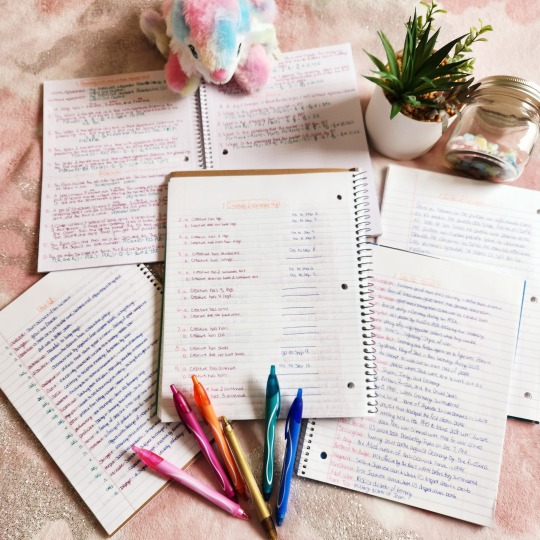
Tuesday, April 2, 2024
I finished up a little earlier than usual today with everything, so I went out to the park behind my house to walk and get some fresh air. It was nice. I really enjoy the trail because it goes into an area full of trees and there are cute bridges and a little stream and some wooden platforms and a gazebo at different points. There is also a rock garden on the outskirts near the main road, but the hill to get up there is slightly steep. You can take that path or go up the stone stairs. It's relaxing. I like to do walking meditations there. I used to go with my brother a lot, but since he's away at university, I go mostly by myself when I'm not with my parents. Don't worry, I have things to keep me safe when I'm by myself, but the neighborhood the park is in has a very low crime rate and there are usually several older individuals on this particular trail too.
I hope everyone is having an enjoyable week thus far.
Tasks Completed:
Geometry - Reviewed independent probability + learned about probability of independent and dependent events + practice + honors work
Lit and Comp II - Reviewed Unit 22 vocabulary + read chapter 49 of Emma by Jane Austen
Spanish 2 - completed the Interior Designer assignment
Bible I - Read 1 Samuel 3-4
World History - Read intro to WWII unit + copied key terms + looked over WWII reading notes + read about WWII on the home front
Biology with Lab - Completed dichotomous key creation assignment
Foundations - Read more on sincerity + completed the next quiz on Read Theory + created an advertisement
Piano - 60-minute piano lesson + practiced for one hour
Khan Academy - Completed World History Unit 6: Lesson 10 (parts 1-3)
CLEP - Completed Module 12.0 introduction video
Streaming - Watched Hitler’s Circle of Evil episode 7
Duolingo - Studied for 15 minutes (Spanish, French, Chinese) + completed daily quests
Reading - Read pages 288-318 of Beneath the Wide Silk Sky by Emily Inouye Huey and finished the book
Chores - Laundry
Activities of the Day:
Personal Bible Study (1 Peter 2)
Ballet
Pointe
Journal/Mindfulness
-
What I’m Grateful for Today:
I am grateful for funny squirrels that are always doing cute things around the park.
Quote of the Day:
The only limit to our realization of tomorrow will be our doubts of today.
-Franklin D. Roosevelt
🎧Romance Op.16 No.2 - Reinhold Glière
#study blog#study inspiration#study motivation#studyblr#studyblr community#study community#study-with-aura
13 notes
·
View notes
Text
Initial Resources for anyone interested in Mycology
Howdy!
I Thought it'd be best to bring any information I can bring to the table for anyone interested in starting to learn fungi and how to forage by introducing the resources I personally use to identify specimen. Do note, however, that I am in North America, and this could vary drastically from where you are (even coasts have remarkably distinct diversity).
Mushrooms Demystified: A Comprehensive Guide to the Fleshy Fungi - David Arora.
This book is a must have for anyone looking to start, seeing as it has thousands of species at hand. This book gives you the initial jump-in point that many need, as it has sections discussing the ins and outs of how to discern morphology, and how to use the most important concept that you will learn for this topic -- the use of dichotomous keys. If you are unfamiliar, they are essentially flow charts that eventually lead you to the species you have, given that you have correctly identified the physical evidence. Another added benefit is that it uses color plates and other imagery to help get the point across. Keep in mind, however, this book was published in 1979-1986 (in my experience, I have found a good few species that ended up being either completely missing from the book, or have been restructured in its family/genus). Overall, this will give you the best advice on how to get your foot in the door for identification of Fungi.
mushroomexpert.com - Michael Kuo.
This website has been meticulously created by Michael Kuo, a brilliant man with a lot of help from the mycological community. Mushroomexpert.com in my experience has a much more frequently updated AND up to date collection of taxonomy, as well as extra information that you would enjoy having (such as chemical tests, and microscopic evidence). Where Mushrooms Demystified lacks, Kuo's website certainly makes up for it. Now, as he makes it a very important note in the main page of his site -- You will NOT find information on the edibility of Mushrooms on this website, and I support that. If you want to find out what's edible and what's not, that will take years and years of experience with your foraging skill and the environment you live in. Don't expect to be able to eat what you catch for a long, long time.
namyco.org - North American Mycology Association
Now, NAMA may be a little less evident on why you would need this to identify anything! However, this is also a fantastic resource for many things you could need. For starters, you can find your states mycological club and join it! That alone is a benefit -- a community that fosters this research with you. There is also the section about their own publications - which, the more resources the merrier! You can also find many other wings of information that may be important on your way through this wonderful science. (hopefully you heed mine and many others warnings when we say PLEASE DONT EAT THINGS YOU DONT KNOW).
To wrap up this first post, I want to thank you for reading this and I would like to welcome you to Mycology. It's an extremely fascinating field that has grasped my interest to an extreme. The study of fungi is a very new type of field (compared to something, say, like zoology) and still has a lot of wonder and mysteries to be solved. Of course, its not as simple as looking at a mushroom and saying "I know that its this!", you will find that there are many tests and things that you can ponder over to be sure of what you have.
If you want to know where you should start while you wait for your books to come in, id say start here on Michael Kuo's website :

Remember, nothing here is a replacement for formal education and experience, and that I am simply a hobbyist like you. If you have any resources of your own to share, I'll am open to being any information that you have.
Happy Hunting!
#mycology#fungi#biology#Introductory info#Foraging#seriously do not eat what you find unless an expert backs up your confirmation#its better to have a cool collection piece than a upset stomach or poisoned body
10 notes
·
View notes
Text
This textbook suggests that flies who ingest the flesh of Amanita muscaria experience intoxication. While my dichotomous key book explains that A. muscaria is broken down quickly by maggots.
I wonder, then, what it's like to be a maggot born and raised on A. muscaria. Are they completely off their rockers? Is it a party all the time? Is it normal to them? Do they even have the capacity to be intoxicated before they reach adulthood?
1 note
·
View note